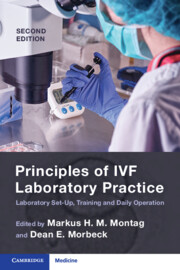Book contents
- Principles of IVF Laboratory Practice
- Principles of IVF Laboratory Practice
- Copyright page
- Contents
- Contributors
- Foreword
- The Evolution of IVF Practice
- Section 1 Starting a New Laboratory and Training Protocols
- Chapter 1 Establishing and Equipping a New IVF Laboratory
- Chapter 2 Basic Embryology Skills and Responsibilities in the IVF Laboratory
- Chapter 3 Sperm Preparation for IVF
- Chapter 4 Oocyte Pick-Up for IVF
- Chapter 5 Embryologist Training: Embryo Transfer
- Chapter 6 ICSI for IVF
- Chapter 7 Embryo Assisted Hatching for IVF
- Chapter 8 Embryo Biopsy for IVF
- Chapter 9 Vitrification for IVF
- Section 2 Pre-procedure Protocols
- Section 3 Gametes
- Section 4 Insemination/ICSI
- Section 5 Fertilization Assessment
- Section 6 Embryo Assessment: Morphology and Beyond
- Section 7 Embryo Cryopreservation
- Section 8 Embryo Transfer
- Section 9 Quality Management
- Index
- References
Chapter 6 - ICSI for IVF
Training Protocol
from Section 1 - Starting a New Laboratory and Training Protocols
Published online by Cambridge University Press: 07 August 2023
- Principles of IVF Laboratory Practice
- Principles of IVF Laboratory Practice
- Copyright page
- Contents
- Contributors
- Foreword
- The Evolution of IVF Practice
- Section 1 Starting a New Laboratory and Training Protocols
- Chapter 1 Establishing and Equipping a New IVF Laboratory
- Chapter 2 Basic Embryology Skills and Responsibilities in the IVF Laboratory
- Chapter 3 Sperm Preparation for IVF
- Chapter 4 Oocyte Pick-Up for IVF
- Chapter 5 Embryologist Training: Embryo Transfer
- Chapter 6 ICSI for IVF
- Chapter 7 Embryo Assisted Hatching for IVF
- Chapter 8 Embryo Biopsy for IVF
- Chapter 9 Vitrification for IVF
- Section 2 Pre-procedure Protocols
- Section 3 Gametes
- Section 4 Insemination/ICSI
- Section 5 Fertilization Assessment
- Section 6 Embryo Assessment: Morphology and Beyond
- Section 7 Embryo Cryopreservation
- Section 8 Embryo Transfer
- Section 9 Quality Management
- Index
- References
Summary
Intracytoplasmic sperm injection (ICSI) is an insemination procedure that allows for a single sperm to be inserted directly into the ooplasm using a needle, therefore bypassing issues involving sperm that may be unable to reach an oocyte and/or bind to the zona pellucida. ICSI is traditionally indicated for male-factor infertility and/or following failed or low fertilization with conventional in vitro fertilization (IVF) in a preceding cycle. Because it is a technically demanding procedure, a structured and closely monitored training programme is required to achieve optimal success rates with ICSI. The objective of this chapter is to outline an ICSI training protocol by which the technical skills are acquired without compromising clinical outcome.
- Type
- Chapter
- Information
- Principles of IVF Laboratory PracticeLaboratory Set-Up, Training and Daily Operation, pp. 38 - 46Publisher: Cambridge University PressPrint publication year: 2023



